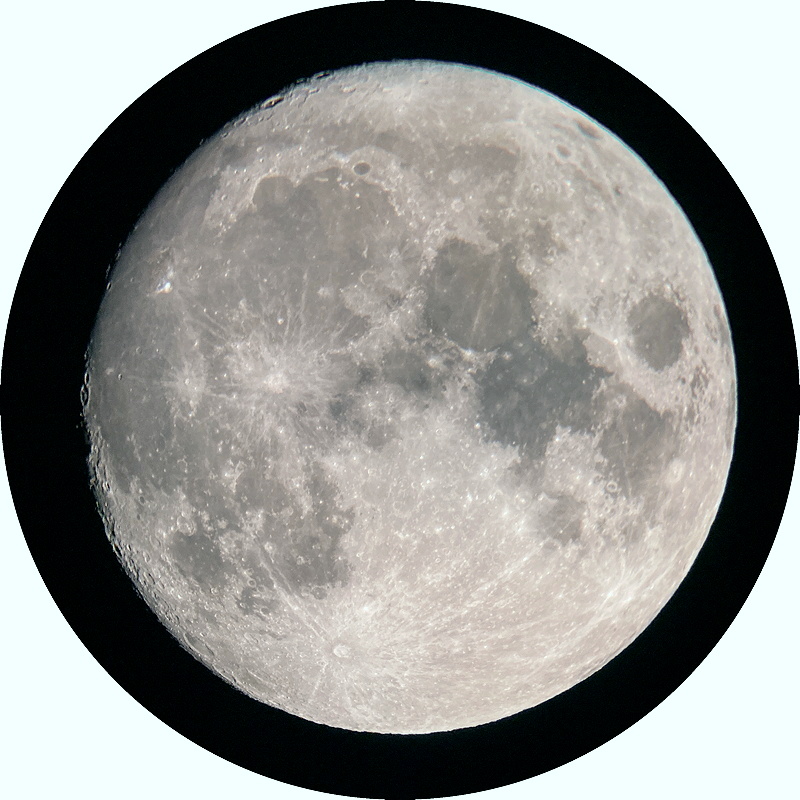iPhone Venus, Moon, Saturn, and Jupiter
Posted: 21 August 2021
Wednesday night, 18 August 2021, a brief heavy rainshower (0.22") came through. It was possibly the last Monsoon storm for awhile. Thursday, 19 August, dawned clear, but clouds began appearing mid-morning. Friday, 20 August, the same pattern occurred. However, by late afternoon it appeared that the sky would be clear enough to open the observatory.
|
Open: Friday, 20 August 2021, 1816 MST Temperature: 84°F |
Session: 1654 Conditions: Mostly clear |
Equipment:
12" f/8 LX600 w/StarLock
2" 24mm UWA eyepiece
2" 9mm 100° eyepiece
2" 30mm eyepiece
2" 5.5mm 100° eyepiece
Camera:
iPhone 11 Pro Max
SYNCed the observatory clock to WWV time signals.
1825 MST: LX600 ON, StarLock OFF, High Precision OFF.
1827 MST: viewed the planet Venus, 102X and 271X. Nice gibbous phase.
Mounted the iPhone 11 Pro Max on the 9mm eyepiece using the Levenhuk adapter.
This is a stack of 615 video frames taken with NightCap Camera (ISO 32, 1/16393sec, 1X lens), afocal 271X.

I then relaxed on the observatory patio bench. With this summer's frequent and heavy Monsoon rainfalls, the mosquitos are more numerous than in any past year since I established Cassiopeia Observatory in 2009. I used this insect repelling band, which was fairly effective at keeping the mosquitos from landing on me.

1904 MST: sunset.
1928 MST: the Moon was rising over the hill to the southeast.
1931 MST: briefly viewed Saturn and its moon Titan, 102X, through a tree. Then returned to the bench.
2014 MST: back in the observatory.
Viewed Saturn, 102X. Then viewed the Moon, 102X and 81X.
Mounted the iPhone on the 30mm eyepiece. Took this afocal 81X photo using NightCap Camera (ISO 32, 1/2500sec, 1X lens).

Then viewed Saturn, 102X and 271X. Four of its moons were visible.
2028 MST: relaxed on the bench while waiting for Saturn to rise higher. Viewed the Moon, Saturn, and Jupiter, 12x50 binoculars. There was a hint of colors on the Moon's surface. The ring system of Saturn was visible. Two moons of Jupiter were visible.
Viewed the double star Albireo, 12x50 binoculars. Both the blue and yellow stars were easily seen in the binoculars.
2045 MST: three moons of Jupiter were visible, 12x50 binoculars.
2100 MST: took this handheld iPhone photo of the moonlit observatory with the constellation of Cassiopeia at the upper right, Camera app (Night Mode, 3 seconds, 1X lens).

2105 MST: back inside the observatory.
Viewed Saturn, 443X. Nice view.
Mounted the iPhone on the 5.5mm eyepiece. This is a stack of 2499 video frames taken with the Camera app (slo-mo, 240fps, 1X lens), afocal 443X.

Viewed Jupiter, 443X.
This is a stack of 2502 video frames taken with the Camera app (slo-mo, 240fps, 1X lens), afocal 443X.

Viewed Jupiter, 443X. Then viewed Jupiter, 271X. The four Galilean Moons were visible in the field-of-view. Viewed Jupiter, 102X. Pretty view of the planet and four moons. Jupiter was at opposition this night. Viewed Jupiter, 81X.
Mounted the iPhone on the 30mm eyepiece and took this iPhone afocal 81X photo using NightCap Camera (ISO 400, 1/400sec, 2X lens). It shows Jupiter and the four moons.

Then took a final look at Jupiter, 102X.
2148 MST: LX600 OFF.
|
Close: Friday, 20 August 2021, 2200 MST Temperature: 72°F |
Session Length: 3h 44m Conditions: Mostly clear |
After I closed the observatory I took this photo of the observatory dome and the constellation of Cassiopeia at the upper right, Camera app (Night Mode, 3 seconds, 1X lens).

Comments are welcome using Email. Twitter users can use the button below to tweet this report to their followers. Thanks.
Cassiopeia Observatory Home Page
Copyright ©2021 Michael L. Weasner / mweasner@me.com
URL = http://www.weasner.com/co/Reports/2021/08/21/index.html
